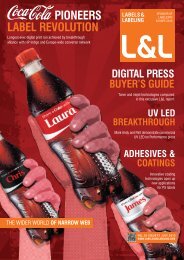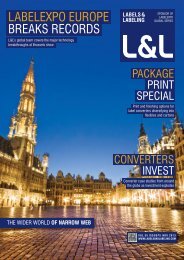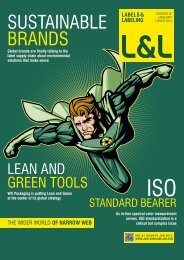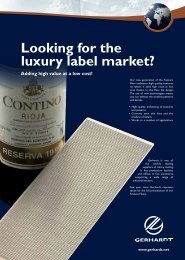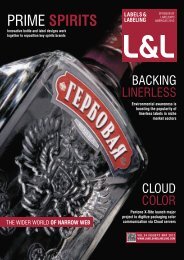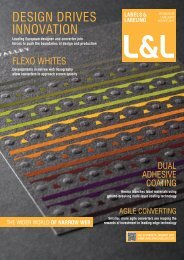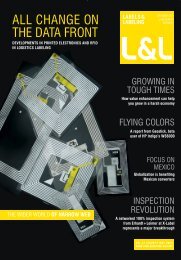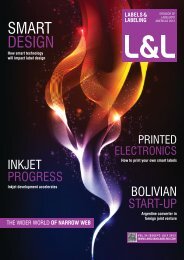SELL
Download - Labels & Labeling
Download - Labels & Labeling
- No tags were found...
You also want an ePaper? Increase the reach of your titles
YUMPU automatically turns print PDFs into web optimized ePapers that Google loves.
LABELS&LABELING |45<br />
of highlight details allows consistent,<br />
pin-sharp halftones with minimal dot<br />
gain. This produces good flesh tones<br />
and vignettes of the type associated<br />
with labels for the cosmetics, toiletries,<br />
healthcare, spirits and wine sectors.<br />
The best of flexo, or indeed high-end<br />
digital printing, can approximate these<br />
effects, but offset achieves them more<br />
easily and more quickly. Furthermore,<br />
as its name suggest, offset printing is an<br />
indirect process using precision-made<br />
rubber blankets to transfer the image to<br />
the substrate. This allows a wide choice<br />
of printable substrates, ranging from<br />
thin unsupported films to textured or<br />
uncoated paper grades.<br />
Similar quality criteria apply to shortto-medium<br />
run flexible packaging<br />
applications. As is happening with flexo,<br />
wider and more versatile presses are<br />
opening up opportunities for producing<br />
shrink sleeves, sachets, pouches,<br />
wraparounds, tube laminates, as well<br />
as small folding cartons. Production<br />
flexibility is essential, which helps explain<br />
the increased interest in offset-based<br />
combination/platform presses. So while<br />
the process colors are offset printed,<br />
typical press lines may include one or<br />
more UV flexo and rotary screen units<br />
for printing large solids, varnishes<br />
and opaque white backgrounds. Other<br />
options include gravure units with forced<br />
air drying for printing metallic inks, heavy<br />
solids and some coatings, as well as hot/<br />
cold foiling with embossing, and inkjet for<br />
variable data.<br />
Offset units normally have two-cylinder<br />
inserts (plate and blanket cylinders),<br />
with a fixed impression cylinder, to<br />
allow variable size changes without web<br />
breaks. Sleeve technology takes this<br />
a stage further when changing plates<br />
and blankets. The sleeve carriers are<br />
easy to handle and store being made<br />
from lightweight materials, such as<br />
polycarbonates and similar synthetics.<br />
Gallus and Nilpeter both use aluminum<br />
carriers, which are said to retain their<br />
dimensional stability over a machine's<br />
service life and are ideal in situations<br />
requiring heavy impression pressures.<br />
The actual wrap-around offset plates<br />
are conventional metal types offering<br />
good offset quality with minimal dot<br />
gain. Working practices must take into<br />
account a non-printing gap, usually of<br />
two to three millimeters, which rules<br />
out wallpaper-type designs. Blankets<br />
sleeves can improve the inking/damping<br />
performance even at high press speeds.<br />
Even when sleeve cylinders replace<br />
costly conventional cylinder cassettes,<br />
offset combination/platform presses<br />
still cost about half as much again as<br />
comparable UV flexo presses. Offset<br />
requires more complex inking trains<br />
with several forme rollers to transfer the<br />
higher viscosity inks to the blanket and,<br />
except with waterless offset, must include<br />
alcohol dampening systems to achieve<br />
a good ink/water balance. The counter<br />
argument is that over the longer-term, as<br />
a quality-driven process, offset is more<br />
economic and offers good productivity<br />
benefits. Industry-standard color<br />
management tools allow users to create<br />
certain Pantone colors from the process<br />
color set. What may require six units on<br />
a flexo press is achievable with four on<br />
an offset press. Furthermore, automatic<br />
controls over the main functions ensure<br />
that operators can quickly achieve good<br />
quality and maintain it with minimal<br />
attention. Importantly, pre-press costs<br />
are far lower than with flexo. The plates<br />
are not only cheaper, they are durable<br />
over long runs and take less time to<br />
make using in-house computer-to-plate<br />
systems. Benefits like these appeal to<br />
printers of wet-glue and in-mold labels<br />
wishing to augment their sheet-fed offset<br />
presses with variable size offset presses.<br />
Where feasible, this introduces the<br />
efficiencies of reel-to-reel or reel-to-sheet<br />
printing and converting, backed by<br />
existing pre-press facilities.<br />
TECHNOLOGY HIGHLIGHTS<br />
Offset combination technology began<br />
with Nilpeter, when in 1994 it introduced<br />
the 330-mm wide M-3300 with the help of<br />
OEM suppliers. Despite initial skepticism,<br />
the company has since sold hundreds<br />
of offset-based presses all over the<br />
world. The current fourth-generation<br />
MO-4 platform press appeared in 2007.<br />
Designed for short-to-long runs, it uses<br />
aluminum-based sleeve technology<br />
and has a web width of 406mm. At<br />
Labelexpo, Nilpeter introduced the Press<br />
Management Center (PMC). Its three<br />
17-inch touch screens allow operators<br />
to control UV-curing rates, electronic<br />
registration and remote inking. Other<br />
features include error diagnostics<br />
backed by an online service function, job<br />
management data and online customer<br />
information. The PMC's functions are<br />
compatible with the international CIP3<br />
operating standard.<br />
MPS's new EXL 410 Sleeve-Offset<br />
combination press has roots in the EO<br />
(Effective Offset) series, also from 2007.<br />
The patented, bearer-less sleeves for<br />
the plate and blanket cylinders give<br />
variable repeat sizes of 18-25 inches. An<br />
overhead rail allows the free positioning<br />
of a compact flexo unit. Short runs are<br />
facilitated by MPS's Automatic Print<br />
Control (APC) system. It covers the<br />
inter-related settings governing forme<br />
rollers, plate sleeve, blanket sleeve and<br />
impression cylinder, including print gap<br />
control, for storage and retrieval from the<br />
job memory function. The EXL-Packaging<br />
is a UV flexo version with webs up to<br />
660mm wide and a top print speed of 300<br />
m/min.<br />
As an OEM supplier, Goebel<br />
manufactures the ink/water system for<br />
the EXL 410. The Darmstadt-based group<br />
also has links with DG press ServiceS<br />
(sic), which in 2009 emerged from the<br />
wreckage of Drent-Goebel as a spares<br />
and service provider. Drent-Goebel's<br />
Vision series of web-offset presses<br />
featured the VSOP (Variable Sleeve<br />
Offset Printing) system, developed by<br />
rotec Hülsensysteme (now with the Flint<br />
Group). DG press ServiceS recently<br />
launched the Vision SP, based on the<br />
520-mm wide Vision, with interchangeable<br />
plate and blanket sleeve cylinders.<br />
The servo-driven impression cylinders<br />
are separately driven from the plate and<br />
blanket cylinders, while the web tension<br />
system is arranged in such a way to print<br />
thin aluminum foils in perfect register, as<br />
JANUARY 2012 | L&L



